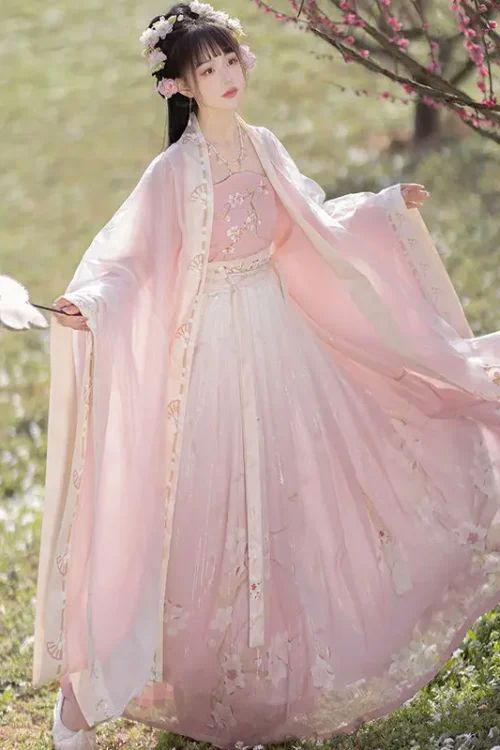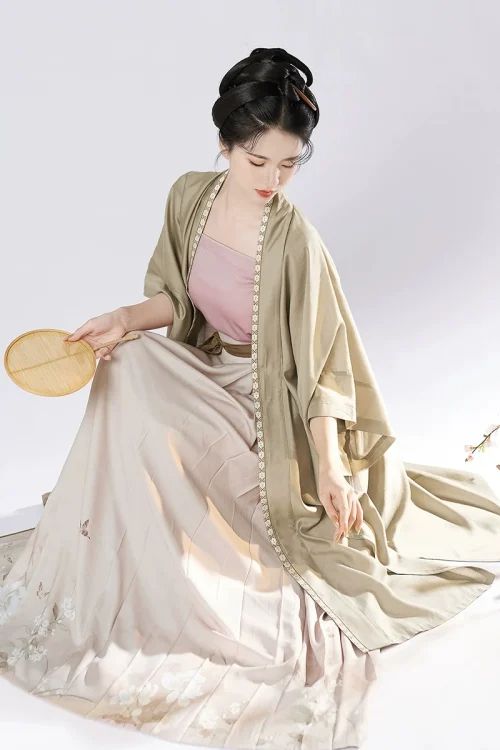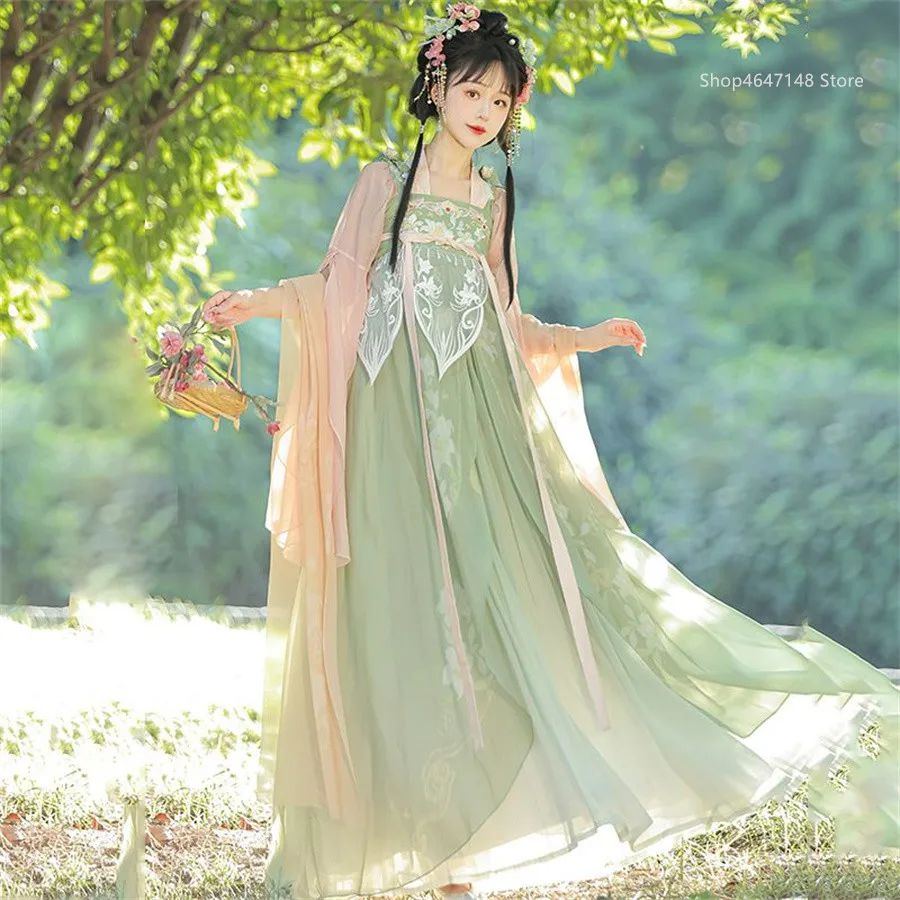The Symbolism and Significance of Bamboo Patterns in 汉服
Bamboo patterns, a prevalent motif in Hanfu, the traditional clothing of the Han Chinese, carry profound cultural and symbolic significance. These patterns, carefully woven or embroidered onto the garments, go beyond aesthetics, representing a rich blend of beliefs, values, and aspirations.

Cultural Importance of Bamboo
The bamboo plant is revered in Chinese culture for its resilience, adaptability, and longevity, serving as a strong symbol of strength and perseverance. Its depiction on Hanfu reflects the ability to endure life’s challenges. Additionally, bamboo’s hollow interior symbolizes humility and modesty, virtues highly respected in Chinese society.
Bamboo Patterns Based on Social Status
Different types of bamboo patterns are worn depending on the wearer’s age, social status, and occasion. For example, young unmarried women often wear bamboo shoots, symbolizing purity and innocence, while married women may wear designs featuring mature bamboo stalks, representing fertility and abundance.
Symbolism of Placement and Number of Stalks
The placement of bamboo patterns on Hanfu holds significant meaning. Bamboo on the sleeves or cuffs suggests protection and guidance, while patterns on the skirt or hemline symbolize stability and grounding. The number of bamboo stalks in a pattern also conveys specific messages:
- Three stalks represent longevity
- Five stalks symbolize prosperity
- Seven stalks signify good fortune
Practical Benefits
Beyond its symbolic meaning, bamboo patterns also offer practical advantages. The hollow nature of bamboo allows for breathability, making garments with these patterns suitable for warmer weather. Additionally, bamboo’s natural antibacterial properties help keep the wearer cool and comfortable.
结论
Bamboo patterns in Hanfu are not only decorative but also deeply connected to Chinese cultural values. They represent strength, humility, and perseverance while also conveying important messages related to purity, fertility, and good fortune. The intricate designs and careful placement of these patterns enrich the symbolic language embedded in Hanfu.
Exploring the Different Types of Bamboo Patterns on Hanfu
Hanfu often incorporates intricate bamboo patterns, each with its own symbolism. The bamboo, known for its resilience, longevity, and purity, is a favored motif in Hanfu and comes in various forms based on regional and personal preferences.

Bamboo Shoot Pattern
The bamboo shoot pattern symbolizes new beginnings and growth, often worn by children or young adults to represent their vitality and innocence.
Bamboo Leaf Pattern
The bamboo leaf pattern represents prosperity and good fortune, commonly found on garments worn by adults during festive occasions, emphasizing harmony and peace.
Bamboo Stalk Pattern
The bamboo stalk pattern, with vertical lines resembling bamboo stems, conveys strength and masculinity, making it a popular choice for men’s garments.
Bamboo Forest Pattern
The bamboo forest pattern, depicting a grove of bamboo trees, symbolizes unity and harmony and is often worn by women, reflecting balance and connection to nature.
Bamboo Combined with Other Elements
Elaborate bamboo patterns that incorporate birds, animals, or flowers are often seen in garments worn by nobility or on special occasions. For instance, the bamboo and crane pattern symbolizes longevity, while bamboo and phoenix represents prosperity and happiness.
结论
The choice of bamboo pattern in Hanfu is not just aesthetic; it conveys cultural significance, reflecting the wearer’s age, gender, and status. Each pattern carries unique messages and helps preserve the rich cultural heritage of Hanfu.
The Evolution of Bamboo Patterns in Hanfu Throughout History
The evolution of bamboo patterns in Hanfu reflects China’s rich cultural heritage and changing artistic trends. Bamboo, a symbol of resilience and longevity, has remained a prominent motif in Hanfu over centuries, with its representation evolving alongside shifts in societal values and artistic expression.
Han Dynasty (206 BCE – 220 CE)
During the Han Dynasty, bamboo patterns were stylized and geometric, featuring simple shapes and lines. These designs were seen on silk robes and accessories, emphasizing the elegance and refinement of Han court attire.

Tang Dynasty (618 – 907 CE)
In the Tang Dynasty, bamboo patterns became more naturalistic and detailed, incorporating leaves and stems to create a sense of vitality. These patterns were worn by both men and women, symbolizing the connection between humanity and nature.

Song Dynasty (960 – 1279 CE)
The Song Dynasty saw bamboo patterns reach a high level of refinement. Artists used shading and gradation to create lifelike bamboo designs. The use of gold and silver threads added sophistication, reflecting the intellectual and artistic pursuits of the time.

Ming Dynasty (1368 – 1644 CE)
During the Ming Dynasty, bamboo patterns became more simplified, focusing on the essential elements of bamboo. This approach aligned with the values of scholars and officials, emphasizing simplicity and integrity.

Qing Dynasty (1644 – 1912 CE)
Bamboo patterns in the Qing Dynasty were often combined with other motifs, like flowers, birds, and landscapes, reflecting the eclectic style of Qing court attire and symbolizing harmony, prosperity, and beauty.
现代 Times
Today, bamboo patterns have experienced a resurgence. Contemporary designers reimagine these traditional patterns with modern creativity, making them relevant for modern fashion while maintaining their deep cultural roots.

结论
The evolution of bamboo patterns in Hanfu over centuries reflects the changing values, artistry, and culture of Chinese society. From the stylized designs of ancient dynasties to the innovative interpretations of today, bamboo remains a timeless and enduring symbol of Chinese heritage.
Bamboo Pattern on Hanfu is only the one of patterns on Hanfu ,you can have more understanding about hanfu’s pattern in our website:https://cheongsam.net/product-category/hanfu/
